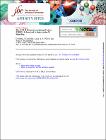| dc.contributor.author | O'NEILL, LUKE | en |
| dc.date.accessioned | 2014-12-17T13:14:07Z | |
| dc.date.available | 2014-12-17T13:14:07Z | |
| dc.date.issued | 2013 | en |
| dc.date.submitted | 2013 | en |
| dc.identifier.citation | Connolly DJ, O'Neill LA, McGettrick AF, The GOLD Domain-containing Protein TMED1 Is Involved in Interleukin-33 Signaling., The Journal of biological chemistry, 288, 8, 2013, 5616-5623 | en |
| dc.identifier.other | Y | en |
| dc.identifier.uri | http://hdl.handle.net/2262/72556 | |
| dc.description | PUBLISHED | en |
| dc.description.abstract | The proinflammatory danger signal IL-33, which is released from damaged or dying cells, achieves its effects via the IL-1R family member ST2L. The detection of IL-33 by ST2L initiates downstream signaling pathways that result in the activation of MAPKs and NF-κB. Here, we show that TMED1 associates with ST2L. Using a series of mutation and deletion constructs, we demonstrate that this interaction is mediated by the GOLD domain of TMED1 and the TIR domain of ST2L. Our findings also demonstrate that TMED1 is required for optimal IL-33-induced IL-8 and IL-6 production. This discovery provides additional support to the concept that the TMED family members are important players in innate immune signaling. | en |
| dc.format.extent | 5616-5623 | en |
| dc.language.iso | en | en |
| dc.relation.ispartofseries | The Journal of biological chemistry | en |
| dc.relation.ispartofseries | 288 | en |
| dc.relation.ispartofseries | 8 | en |
| dc.rights | Y | en |
| dc.subject | Immunology | en |
| dc.title | The GOLD Domain-containing Protein TMED1 Is Involved in Interleukin-33 Signaling. | en |
| dc.type | Journal Article | en |
| dc.type.supercollection | scholarly_publications | en |
| dc.type.supercollection | refereed_publications | en |
| dc.identifier.peoplefinderurl | http://people.tcd.ie/laoneill | en |
| dc.identifier.rssinternalid | 84238 | en |
| dc.identifier.doi | http://dx.doi.org/10.1074/jbc.M112.403899 | en |
| dc.rights.ecaccessrights | openAccess | |
| dc.subject.TCDTheme | Immunology, Inflammation & Infection | en |




